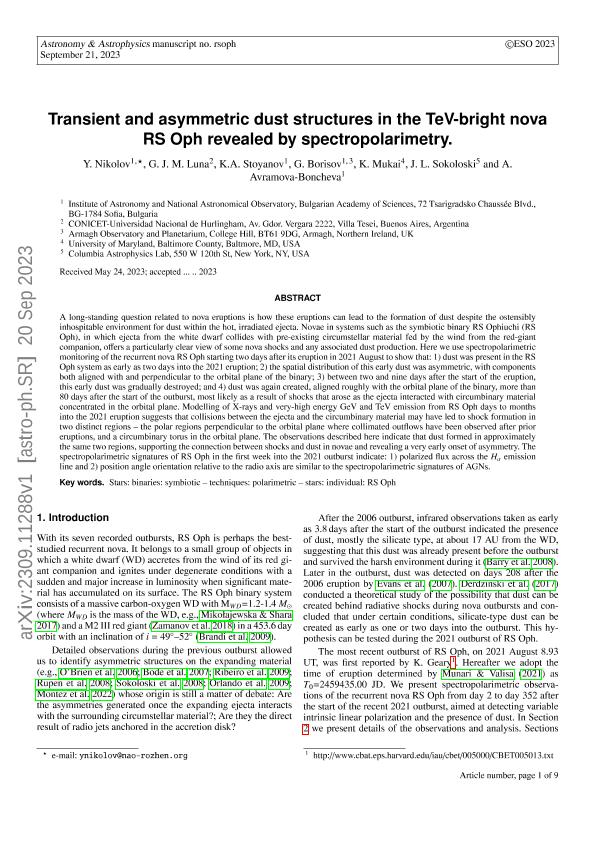Artículo
Transient and asymmetric dust structures in the TeV-bright nova RS Oph revealed by spectropolarimetry
Nikolov, Y.; Luna, Gerardo Juan Manuel ; Stoyanov, K. A.; Borisov, G.; Mukai, K.; Sokoloski, J. L.; Avramova Boncheva, A.
; Stoyanov, K. A.; Borisov, G.; Mukai, K.; Sokoloski, J. L.; Avramova Boncheva, A.
 ; Stoyanov, K. A.; Borisov, G.; Mukai, K.; Sokoloski, J. L.; Avramova Boncheva, A.
; Stoyanov, K. A.; Borisov, G.; Mukai, K.; Sokoloski, J. L.; Avramova Boncheva, A.
Fecha de publicación:
10/2023
Editorial:
EDP Sciences
Revista:
Astronomy and Astrophysics
ISSN:
0004-6361
Idioma:
Inglés
Tipo de recurso:
Artículo publicado
Clasificación temática:
Resumen
A long-standing question related to nova eruptions is how these eruptions might lead to dust formation, despite the ostensibly inhospitable environment for dust within the hot, irradiated ejecta. In the novae of systems such as the symbiotic binary RS Ophiuchi (RS Oph), ejecta from the white dwarf collide with pre-existing circumstellar material fed by the wind from the red-giant companion, offering a particularly clear view of some nova shocks and any associated dust production. In this work, we use the spectropolarimetric monitoring of the recurrent nova RS Oph starting two days after its eruption in August 2021 to show that: 1) dust was present in the RS Oph system as early as two days into the 2021 eruption; 2) the spatial distribution of this early dust was asymmetric, with components both aligned with and perpendicular to the orbital plane of the binary; 3) between two and nine days after the start of the eruption, this early dust was gradually destroyed; and 4) dust was again created, aligned roughly with the orbital plane of the binary more than 80 days after the start of the outburst, most likely as a result of shocks that arose as the ejecta interacted with circumbinary material concentrated in the orbital plane. The modeling of X-rays and very-high-energy (GeV and TeV) emission from RS Oph days to months into the 2021 eruption suggests that collisions between the ejecta and the circumbinary material may have led to shock formation in two distinct regions: the polar regions perpendicular to the orbital plane, where collimated outflows have been observed after prior eruptions, and a circumbinary torus in the orbital plane. The observations described here indicate that dust formed in approximately the same two regions, supporting the connection between shocks and dust in novae and revealing a very early onset of asymmetry. The spectropolarimetric signatures of RS Oph in the first week into the 2021 outburst indicate: 1) polarized flux across the Hα emission line and 2) the position angle orientation relative to the radio axis is similar to what is seen from the spectropolarimetric signatures of active galactic nuclei (AGNs).
Palabras clave:
BINARIES: SYMBIOTIC
,
STARS: INDIVIDUAL: RS OPH
,
TECHNIQUES: POLARIMETRIC
Archivos asociados
Licencia
Identificadores
Colecciones
Articulos(SEDE CENTRAL)
Articulos de SEDE CENTRAL
Articulos de SEDE CENTRAL
Citación
Nikolov, Y.; Luna, Gerardo Juan Manuel; Stoyanov, K. A.; Borisov, G.; Mukai, K.; et al.; Transient and asymmetric dust structures in the TeV-bright nova RS Oph revealed by spectropolarimetry; EDP Sciences; Astronomy and Astrophysics; 679; 10-2023; 1-9
Compartir
Altmétricas



